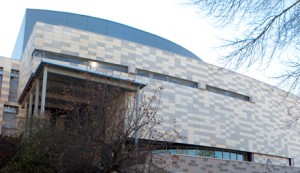 The brain is as complex as a universe — a web of connections that mesh with the nervous system to control the myriad working parts of the body. When it’s damaged by drug abuse, trauma or disease, such critical functions as memory, movement, speaking and learning can be seriously affected.
The brain is as complex as a universe — a web of connections that mesh with the nervous system to control the myriad working parts of the body. When it’s damaged by drug abuse, trauma or disease, such critical functions as memory, movement, speaking and learning can be seriously affected.
To study such an intricate organ, scientists need high-tech labs that can handle equipment measuring in nanoseconds the electrical impulses sent and received by the brain. During the last several decades, researchers at Binghamton University have built one of the top behavioral neuroscience (BNS) programs in the country, although they have conducted their experiments in labs built for very different purposes a very long time ago.
Scientists have done pathbreaking research in these retrofitted spaces, but there comes a point when space limitations constrain the progress of research. That’s what makes the move to Binghamton’s new Science 5 building so exciting.
“BNS research has been a great strength of Binghamton for the last quarter century or more, and it’s grown piecemeal,” Harpur College Dean Donald Nieman says. “It was time for us to take the next step and invest in a facility that’s state of the art for this kind of research.”
Science 5 reflects the growth of Binghamton’s BNS program, which integrates the cellular and molecular techniques of biological neuroscience with the sensory and behavioral aspects of psychology. With the new facility, BNS researchers will deepen their study of an array of critical issues that affect health and well-being — addiction, stress, obesity, memory and neurological disorders such as Parkinson’s and Alzheimer’s disease. By determining the genesis of these problems and better understanding how they affect the brain, their research may lead to interventions to treat them.
The building is designed to foster collaboration. Traditionally, every scientist has his or her own laboratory space and equipment, which is not only expensive, but creates silos of knowledge and techniques. The new space builds a shared environment, encouraging scientists doing similar work in wet labs and data entry rooms to interact, learn from one another, ask novel questions and develop creative strategies for answering them.
“Team research is the future of scientific discovery and the Science 5 building sets the stage for such progress,” says Lisa Savage, professor and graduate coordinator. Although there is already collaboration among BNS researchers, the design of the building and the shared space and equipment will open additional possibilities. And that will help an excellent program become even better.
“You’ll see someone working 10 feet away from you doing a procedure that you may not know about,” Savage explains. “So you may ask them about it and what it does, or think about how you might potentially use that type of procedure in your own research.”
Designed to LEED gold standards, the space boasts a partial green roof, energy-efficient lighting and climate control measures and other environmentally friendly features. And rather than clear out additional space on campus, Science 5 was constructed on part of the old plaza between Science 3 and Science 4.
Nieman says the Science 5 vivarium is the culmination of impressive efforts by faculty members hired years ago. As their own work gained prominence, they fostered an environment that attracted young talent and helped them succeed in their own work.
“Because the core faculty here have international reputations, we’re able to recruit really good faculty,” Nieman says. “And because people like Linda and Skip [Spear] have such high standards, they recruit well and they set the bar high for those they hire. People don’t earn tenure unless they’re highly productive. But at the same time, our senior faculty are really good mentors, and they create an environment where people can succeed.”
Linda Spear’s exceptional work was recognized in 2010, when the National Institute on Alcohol Abuse and Alcoholism awarded a five-year, $8.5 million grant to fund the Developmental Exposure Alcohol Research Center (DEARC). Spear, distinguished professor of psychology, serves as its director. The DEARC is a joint venture of Binghamton University, SUNY Upstate Medical University and SUNY Cortland.
The grant is one of the many garnered by the department. In fact, 80 percent of the faculty conduct sponsored research, well above the national average for both psychology and neuroscience. Such external funding has allowed the department to be self-sufficient and hire faculty even during lean times.
Of course, in today’s economic climate, there are never enough research dollars to go around. So universities are seeking partners that complement their strengths and give them a competitive advantage. Binghamton and SUNY Upstate Medical University have started to look at possibilities for working together.
“What you’re seeing with the recent articulation agreement is another layer being graphed onto this,” Nieman says. “We’ve set up plans that will allow our graduate students to take classes at Upstate and our undergraduates to apply for research opportunities. What we’re really trying to do is build a more broad-based collaboration. We don’t have a medical school, but we do have research and teaching strengths that Upstate doesn’t have.”







